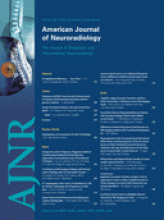Abstract
BACKGROUND AND PURPOSE: Neuropsychologic deficits are well-known sequelae of traumatic brain injury. However, the cerebral correlates of these deficits are still unclear. The aim of the present study was to elucidate the regions of cerebral dysfunction correlated with such neuropsychologic deficits after traumatic brain injury.
METHODS: Sets of fluorine-18 fluorodeoxyglucose–positron-emission tomography (FDG-PET) images in the resting state were obtained from 12 patients with neuropsychologic deficits after diffuse axonal injury and from 32 healthy volunteers. The cortical metabolic activity of each subject’s PET image sets was extracted using 3D stereotactic surface projection (3D-SSP). A “normal” data base was created using the extracted datasets of the healthy subjects. The patients’ datasets were compared with the normal data base by calculating a statistical Z-score on a pixel-by-pixel basis in searches for focal metabolic abnormalities.
RESULTS: Group comparisons revealed hypometabolism in the cingulate gyrus with additional involvement of the lingual gyrus and cuneus. Individual case-by-case analyses disclosed differences in the site and extent of the hypometabolism in the cingulate gyrus of each case. Predominant hypometabolism was found in the anterior cingulate gyrus of 6 patients, the middle cingulate gyrus of 2 patients, and the posterior cingulate gyrus of 4 patients.
CONCLUSION: Interpretation of FDG-PET using 3D-SSP facilitates the identification of regional hypometabolism in the cerebral cortex of patients after diffuse axonal injury. Dysfunction of the cingulate gyrus, lingual gyrus, and cuneus may play a crucial role in neuropsychologic deficits after traumatic brain injury.
- Copyright © American Society of Neuroradiology












